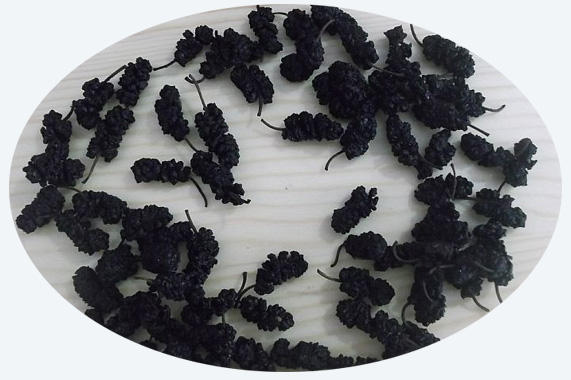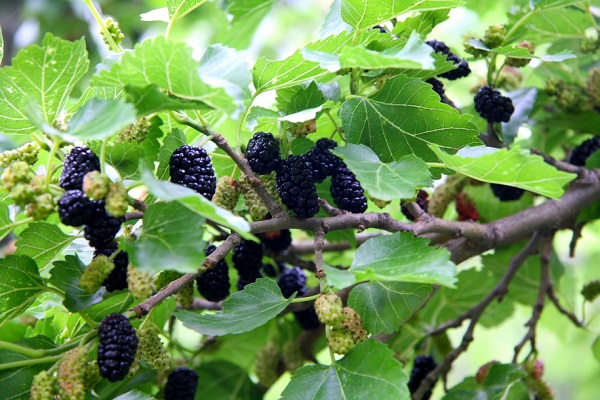Drytech heat pump dryer use for drying mulberry
Mulberry
Morus, a genus of flowering plants in the family Moraceae, comprises 10–16 species of deciduous trees commonly known as mulberries growing wild and under cultivation in many temperate world regions.The closely related genus Broussonetia is also commonly known as mulberry, notably the Paper Mulberry, Broussonetia papyrifera. Mulberries are swift-growing when young, but soon become slow-growing and rarely exceed 10–15 m (33–49 ft) tall. The leaves are alternately arranged, simple, often lobed, more often lobed on juvenile shoots than on mature trees, and serrated on the margin.The trees can be monoecious or dioecious.The mulberry fruit is a multiple fruit, 2–3 cm (0.79–1.18 in) long. Immature fruits are white, green, or pale yellow. In most species, the fruits turn pink and then red while ripening, then dark purple or black, and have a sweet flavor when fully ripe. The fruits of the white-fruited cultivar are white when ripe; the fruit in this cultivar is also sweet but has a very mild flavor compared with the darker variety.
Uses and cultivation
Mulberry fruit in Libya
The ripe fruit is edible and is widely used in pies, tarts, wines, cordials and tea. The fruit of the black mulberry, native to southwest Asia, and the red mulberry, native to eastern North America, have the strongest flavor, which has been likened to 'fireworks in the mouth'.The fruit of the white mulberry, an east Asian species which is extensively naturalized in urban regions of eastern North America, has a different flavor, sometimes characterized as refreshing and a little tart, with a bit of gumminess to it and a hint of vanilla. In North merica the white mulberry is considered an invasive exotic and has taken over extensive tracts from native plant species, including the red mulberry. The mature plant contains significant amounts of resveratrol, particularly in stem bark. The fruit and leaves are sold in various forms as nutritional supplements. Unripe fruit and green parts of the plant have a white sap that may be toxic, stimulating, or mildly hallucinogenic.Black, red, and white mulberry are widespread in southern Europe, the Middle East, northern Africa and Indian Subcontinent where the tree and the fruit have names under regional dialects. Jams and sherbets are often made from the fruit in this region. Black mulberry was imported to Britain in the 17th century in the hope that it would be useful in the cultivation of silkworms. It was much used in folk medicine, especially in the treatment of ringworm. Mulberries are also widespread in Greece, particularly in the Peloponnese, which in the Middle Ages was known as Morea (Greek: Μωριάς, Morias), deriving from the Greek word for the tree (Greek: Μουριά, Μouria).Mulberries can be grown from seed, and this is often advised as seedling-grown trees are generally of better shape and health, but they are most often planted from large cuttings which root readily. The mulberry plants which are allowed to grow tall with a crown height of 5–6 feet from ground level and a stem girth of 4–5 inches or more is called tree mulberry. They are specially raised with the help of well-grown saplings 8–10 months old of any of the varieties recommended for rain-fed areas like S-13 (for red loamy soil) or S-34 (black cotton soil) which are tolerant to drought or soil-moisture stress conditions. Usually, the plantation is raised and in block formation with a spacing of 6 feet x 6 feet, or 8 feet x 8 feet, as plant to plant and row to row distance. The plants are usually pruned once a year during the monsoon season (July–August) to a height of 5–6 feet and allowed to grow with a maximum of 8–10 shoots at the crown. The leaves are harvested 3–4 times a year by a leaf picking method[clarification needed] under rain-fed or semi-arid conditions, depending on the monsoon.The tree branches pruned during the fall season (after the leaves have fallen) are cut and used to make durable baskets supporting agriculture and animal husbandry.Some North American cities have banned the planting of mulberries because of the large amounts of pollen they produce, posing a potential health hazard for some pollen allergy sufferers. In actuality, it is only the male mulberry trees that produce pollen; this light-weight pollen can be inhaled deeply into the lungs, sometimes triggering asthma. Conversely, female mulberry trees produce all-female flowers, which draw pollen and dust from the air. Because of this pollen-absorbing feature, all-female mulberry trees have an OPALS allergy scale rating of just 1, and are considered "allergy-free".Fortunately, mulberry tree scion wood can easily be grafted onto other mulberry trees during the winter, when the tree is dormant. One common scenario is converting a problematic male mulberry tree to an allergy-free female tree, by grafting all-female mulberry tree scions to a male mulberry that has been pruned back hard.However, any new growth from below the graft(s) must be removed, as they would be from the original male mulberry tree.
Mulberry
Morus, a genus of flowering plants in the family Moraceae, comprises 10–16 species of deciduous trees commonly known as mulberries growing wild and under cultivation in many temperate world regions.The closely related genus Broussonetia is also commonly known as mulberry, notably the Paper Mulberry, Broussonetia papyrifera. Mulberries are swift-growing when young, but soon become slow-growing and rarely exceed 10–15 m (33–49 ft) tall. The leaves are alternately arranged, simple, often lobed, more often lobed on juvenile shoots than on mature trees, and serrated on the margin.The trees can be monoecious or dioecious.The mulberry fruit is a multiple fruit, 2–3 cm (0.79–1.18 in) long. Immature fruits are white, green, or pale yellow. In most species, the fruits turn pink and then red while ripening, then dark purple or black, and have a sweet flavor when fully ripe. The fruits of the white-fruited cultivar are white when ripe; the fruit in this cultivar is also sweet but has a very mild flavor compared with the darker variety.
Uses and cultivation
Mulberry fruit in Libya
The ripe fruit is edible and is widely used in pies, tarts, wines, cordials and tea. The fruit of the black mulberry, native to southwest Asia, and the red mulberry, native to eastern North America, have the strongest flavor, which has been likened to 'fireworks in the mouth'.The fruit of the white mulberry, an east Asian species which is extensively naturalized in urban regions of eastern North America, has a different flavor, sometimes characterized as refreshing and a little tart, with a bit of gumminess to it and a hint of vanilla. In North merica the white mulberry is considered an invasive exotic and has taken over extensive tracts from native plant species, including the red mulberry. The mature plant contains significant amounts of resveratrol, particularly in stem bark. The fruit and leaves are sold in various forms as nutritional supplements. Unripe fruit and green parts of the plant have a white sap that may be toxic, stimulating, or mildly hallucinogenic.Black, red, and white mulberry are widespread in southern Europe, the Middle East, northern Africa and Indian Subcontinent where the tree and the fruit have names under regional dialects. Jams and sherbets are often made from the fruit in this region. Black mulberry was imported to Britain in the 17th century in the hope that it would be useful in the cultivation of silkworms. It was much used in folk medicine, especially in the treatment of ringworm. Mulberries are also widespread in Greece, particularly in the Peloponnese, which in the Middle Ages was known as Morea (Greek: Μωριάς, Morias), deriving from the Greek word for the tree (Greek: Μουριά, Μouria).Mulberries can be grown from seed, and this is often advised as seedling-grown trees are generally of better shape and health, but they are most often planted from large cuttings which root readily. The mulberry plants which are allowed to grow tall with a crown height of 5–6 feet from ground level and a stem girth of 4–5 inches or more is called tree mulberry. They are specially raised with the help of well-grown saplings 8–10 months old of any of the varieties recommended for rain-fed areas like S-13 (for red loamy soil) or S-34 (black cotton soil) which are tolerant to drought or soil-moisture stress conditions. Usually, the plantation is raised and in block formation with a spacing of 6 feet x 6 feet, or 8 feet x 8 feet, as plant to plant and row to row distance. The plants are usually pruned once a year during the monsoon season (July–August) to a height of 5–6 feet and allowed to grow with a maximum of 8–10 shoots at the crown. The leaves are harvested 3–4 times a year by a leaf picking method[clarification needed] under rain-fed or semi-arid conditions, depending on the monsoon.The tree branches pruned during the fall season (after the leaves have fallen) are cut and used to make durable baskets supporting agriculture and animal husbandry.Some North American cities have banned the planting of mulberries because of the large amounts of pollen they produce, posing a potential health hazard for some pollen allergy sufferers. In actuality, it is only the male mulberry trees that produce pollen; this light-weight pollen can be inhaled deeply into the lungs, sometimes triggering asthma. Conversely, female mulberry trees produce all-female flowers, which draw pollen and dust from the air. Because of this pollen-absorbing feature, all-female mulberry trees have an OPALS allergy scale rating of just 1, and are considered "allergy-free".Fortunately, mulberry tree scion wood can easily be grafted onto other mulberry trees during the winter, when the tree is dormant. One common scenario is converting a problematic male mulberry tree to an allergy-free female tree, by grafting all-female mulberry tree scions to a male mulberry that has been pruned back hard.However, any new growth from below the graft(s) must be removed, as they would be from the original male mulberry tree.
 Call Us:
Call Us:  E-mail:
E-mail: 



 Address: Guangzhou City, Guangdong Province,P.R.China
Address: Guangzhou City, Guangdong Province,P.R.China
 TEL: +86-159-8924-9151/Whatsapp
TEL: +86-159-8924-9151/Whatsapp
 E-mail:
E-mail: